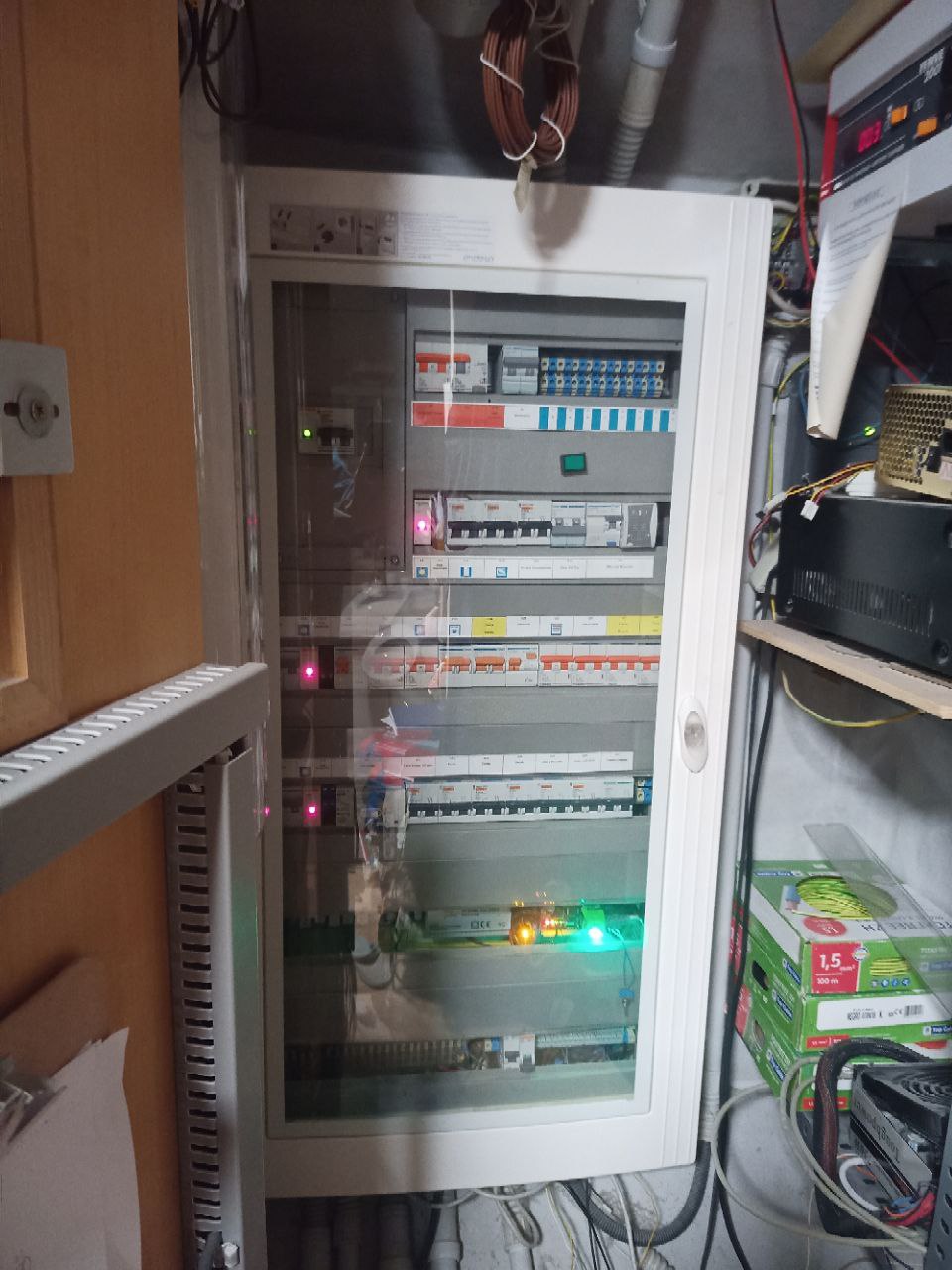There are the targets to install vesta controllers on this home. After this deploy all basic devices and switches will be controlled by computer. As this is not the first domotic aproximation, there are several devices working temporarly:

Target 0: Storage Room
It’s on the basement. From here we control all the lights, our electric car charging facility, our private lights at public parking and monitor door status.
Actually a former Vesta device is working, but not connected to the system because is not compatible to the current provisional system.

Target 1: Water inlet
Placed in the public parking at our side. Will monitor water inlet, decalcifier functions and also will control bypasses and general tap. Currently has no vesta devices, but it does have a power outlet and a network point.

Target 2: Community parking
This electrical cabinet is not strictly part of the home. It belongs to the four neighbors of the property. You currently features a Vesta controller with an old version installed. There is an ethernet connection to the local network. It is currently not physically connected to avoid version conflicts. The objective is to incorporate this installation into the network and replace the current automatic door control module to a virtual device placed in the controller itself.

Target 3: Train layout
The previous version of the home automation system extended its control to a large model railway installed in the living room. It was useful to control the lighting of buildings, platforms and lampposts from the home automation system itself. Unfortunately the lighting controller in the room itself broke down and I had to replace it with this one, leaving the model railway unpowered. It may seem like an eccentricity, but this corner of the house has been one of the main reasons for undertaking this project.

Target 4: Living room
The controller had 16 inputs and 16 outputs, but only 3 inputs and 5 outputs were used, two of which were used to open or close the electric shutters that give light to the room. The new module will have even more inputs and outputs. I will take the opportunity to control the lights of the houses in the model train, because my idea is to replicate in one of them the current lighting status of the house itself, associating each room of a miniature building with the real lighting of another room in the house. House. Not only will this be a fun way to “give life” to buildings, but it will also be useful as a real time status indicator.

Target 5: Kitchen
The most visible area of the kitchen is the breakfast bar that separates it from the living room. This piece of furniture has an illuminated showcase that, originally, was controlled with a pair of switches located on both sides. In 2021 I installed a Vesta module connected to the network by a PLC and now the lighting is coordinated with the kitchen controls located at the other end and belonging to another home automation sector. I want to discriminate the lights more, which will allow me to assign the exact amount of lighting I need according to the moment. I also want to get data from the dishwasher and possibly make the sink faucet work with solenoid valves.

Target 6: Main electrical cabinet
This was the heart of the first home automation system I installed in 2005 and its 16 outlets managed lights, plugs and a battery charger connected to a power inverter. The problem with having everything concentrated in one place is that when something fails in it, the entire system collapses. For this reason, the current controller (another Vesta) manages the lighting at the entrance to the house, the exterior lantern, the hall light, four kitchen lights and the doorbell. In addition to everything that exists, I want to incorporate three intensity transformers to measure the electrical consumption in real time. This information will be very valuable data for the system, which will allow me to offer the most economical solution depending on the time of day and the electricity rate.

Target 7: Laundry terrace
It is a terrace that leads to an interior space. In it are the washing machine, the dryer and an electric water heater. The three components represent the highest sustained consumption in the house and the aim of home automation will be to connect and disconnect them to reduce the total instantaneous consumption. For this it will be necessary to obtain the status of the heater thermostat and the temperature of the water in the tank.For this it will be necessary to obtain the status of the heater thermostat and the water temperature in the tank. Everything is ready to incorporate a Vesta, although at the moment there is only the electrical cabinet, which contains a basic installation.

Target 8: Child’s bedroom header
There is a home automation controller under the headboard of the bed connected to the buttons on the reading light panel and to the light itself. Thanks to this, the owner of the room could control the four points of light without getting out of bed, and even notify the kitchen if he needed something with the push of a button. In 2018 the controller broke and was not replaced because it was very difficult (and expensive) to find the exact model.

Target 9: Child’s beedrom cabinet
It is connected to the push buttons on the wall and to the main lights. It was the first place in the house to have a working Vesta module, and even though the version is almost five years old, it still works fine.

Target 10: Main bedroom cabinet
This bedroom was the first room in the house to have a controller separate from the main closet (Target 6). In its first version it was controlled by a Microchip PIC and currently with an Inlog module, similar to the ones that are almost everywhere in the house. In addition to the two reading lamps at the head of the house (same as the Target 8), the wall switch, the light in the upper corridor, the light in the laundry room and the light in the bathroom are controlled. The objective is to considerably expand home automation control in this area.

Target 11: Train compartment / Workshop
The best way to understand the role of this room is to follow this link. With two Inlog modules, 8 lights, 2 fans, an air extractor, a train control panel and two simulated technical panels are controlled. This part of the installation will be a project in itself, where I will put all the power of Vesta to the limit.
I have tried to show the current status (April 2022) of the home areas that (I hope) will change over these months. Each installation will be a project itself and at that time I will provide much more detailed information on what exists and how I will control it.






